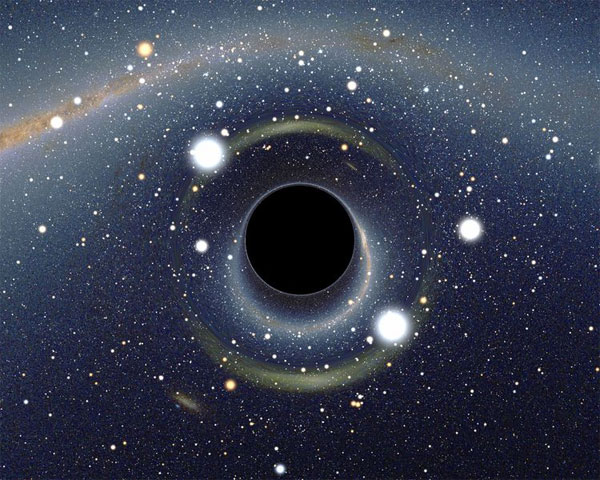The mystery of the star escapes the largest black hole in the Milky Way
The giant star named G2, after "straying" into the space around the Milky Way's supermassive black hole, suddenly escapes and continues to make his mysterious journey.
Recently, astronomers were extremely surprised to discover the object named G2, with very special structure and path, after 'accidentally' straying into the space around the black hole. The largest universe still returns safely and is continuing its journey in orbit.

The largest black hole in the universe called Sagittarius A * has "refused to enjoy" the giant star G2.(Illustration)
Observers discovered G2 in early 2011 when it was moving rapidly toward the supposedly largest black hole in the center of the Milky Way. Many controversies have erupted around this "gas" , largely due to its erratic and unstable trajectory.
Daryl Haggard, a central researcher on the Milky Way, said there have been many gas or stars pulled near the black hole. These objects then often follow an elliptical orbit around the crater, only G2 follows a special trajectory, an 'angular ellipse' or more precisely a line that is almost straight to the hole. black, then it shot straight out of the crater.
'To do that, this strange object needs to lose a sufficient momentum, so that instead of following an orbit , it begins to go straight to the black hole. It can be imagined like a coin rolling on a bowl, if you provide a sufficient kinetic energy for a coin to have a certain speed, it will follow the ring around the bowl, but If there is no momentum, the coin will fall straight to the bottom of the bowl. Thus, it is possible that one factor has lost G2's momentum in the process of moving into the black hole, and that is very difficult to explain, " Haggard said.

Scientists believe that in the process of falling into the largest black hole in the universe, G2 has stolen some energy.(Illustration)
At the time of the G2 discovery, many hypotheses were proposed for the fate of this object. Many people believe that it will suffer from the noodle effect (Spaghettification or Noodle Effect) , which means it will be stretched by the gravitational pull from the black hole, then the gas is heated, ignited and will create rays Electromagnetic radiation can be obtained by modern equipment from the earth, and thus will be able to discover more about the nature of the black hole as well as the gas.
But the incident took place unlike any prediction. Astronomers claim that this gas has come very close to the black hole in the summer of 2014, but it is doubtful that the Milky Way's black hole "refuses" to swallow this object like so many. planets and other space objects.
G2 survived through the black hole, simultaneously drawing a series of questions and assumptions about its nature and origin. In the first week of November, astronomers at UCLA published a new report explaining their views on what G2 really is and how it can overcome such a black hole.
Andrea Ghez, Professor of Physics and Astronomy at UCLA, said in the statement: 'G2 exists and continues its trajectory. It is completely unaffected by black holes, and it is obvious that a mass of ordinary gas will not be able to do this. Besides, there was no phenomenon of fireworks appearing . '.

The image of G2 escapes the attraction of the largest black hole in the universe.(Illustration)
The hypothesis that Ghez's team proposed was G2, in fact, a star that existed in pairs, due to the observations of nearby G2-sized stars in the Milky Way, most of which exist in pairs with together. It is possible that this pair of stars has gone to the black hole while working together to become a massive star. We did not realize it because the combined process could have been covered by the surrounding gas and dust, and it was the energy from the merging process that resisted the giant black hole's gravitational pull.
It can be said that, although G2 is not the first case to be swallowed by black holes, G2 has opened up new theories about one of the previously unexplained phenomena, as well as the nature of the holes Black death in the universe. Currently, scientists are waiting for 2018, when another star named S2 will approach this largest black hole, and hopes it will have the opportunity to gather more valuable data.
- The star flies more than 1,000 km / sec after 'hiding' from the black hole
- Discover the mystery of the most exotic black holes in the universe
- Incidentally the star forms near a black hole
- The black hole in the Milky Way flashes fiercely when 'eating' a star
- 10 fascinating facts about black holes
- New findings help prove the theory of black holes
- The 'lonely star' was kicked out of the Milky Way, forever in nothingness
- The endless dance between the Milky Way
- Monster black holes are 100,000 times bigger than the Sun.
- The first time a black hole was discovered, it swallowed a star
- The painful death of a star ripped apart by a supermassive black hole
- Catching a super rare scene in the universe: Super giant black hole is swallowing up a star
 Van Allen's belt and evidence that the Apollo 11 mission to the Moon was myth
Van Allen's belt and evidence that the Apollo 11 mission to the Moon was myth The levels of civilization in the universe (Kardashev scale)
The levels of civilization in the universe (Kardashev scale) Today Mars, the sun and the Earth are aligned
Today Mars, the sun and the Earth are aligned The Amazon owner announced a secret plan to build a space base for thousands of people
The Amazon owner announced a secret plan to build a space base for thousands of people